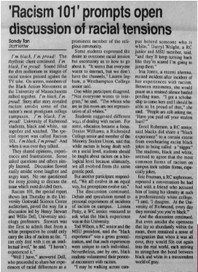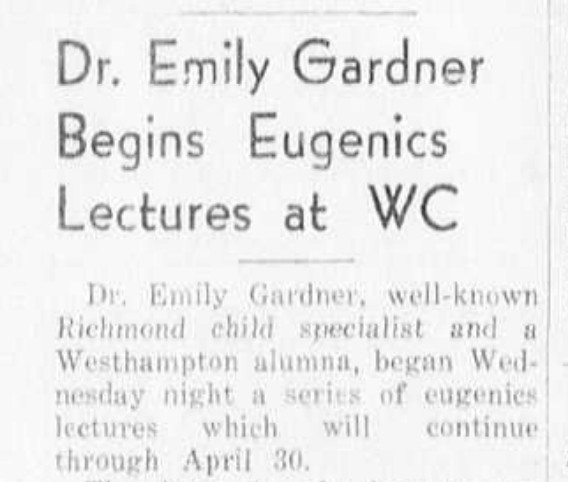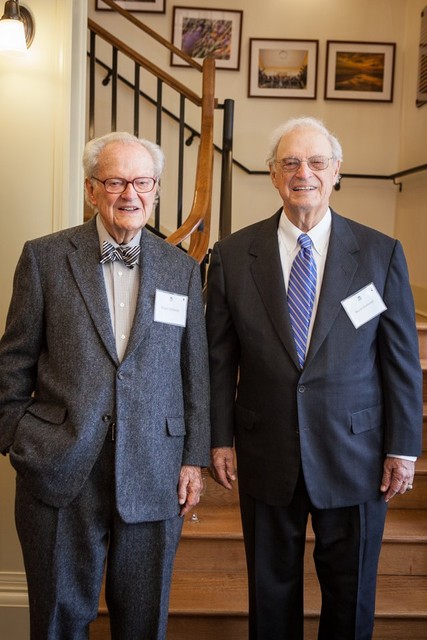The Pauley Auditorium in the Gottwald Science Center
Introduction
Text-to-speech Audio
Images
An article from Richmond's student run newspaper, "The Collegian," describing an event held in 1990 in which students had an open discussion about racial tensions on campus.

An announcement from 1935 in Richmond's student run newspaper, "The Collegian," about a lecture sponsored by the sciences about eugenics.

An article from Richmond's student run newspaper, "The Collegian," describing the school's biology club from 1937 that was focused on the biological differences between races.

Floyd Gottwald, left, pictured next to his brother Bruce.

Backstory and Context
Text-to-speech Audio
Though the building has only existed since the 1970s, with new additions and renovations in the early 2000s, the Gottwald Science Center represents the unification of the sciences on campus after moving from Puryear, Richmond, and Maryland Halls. Curricula have changed throughout the years, moving from lectures on eugenics to a more recent focus on diversity and inclusion in the sciences.
In 1935, the University of Richmond chapter of Mortar Board, a senior academic honor society, hosted a series of lectures on “Changing Aspects in a Changing World”. Dr. Emily Gardner gave a four-part series on eugenics, the practice of selective human breeding, often on racial lines. At the time, and until 1979, Virginia law included the ability to force sterilization upon those deemed unfit to procreate under the Eugenical Sterilization Act of 1924, a law upheld by the 1927 Buck v. Bell case. In 1937, two years after Dr. Gardner’s series, Dr. Robert F. Smart, early biology professor and later dean of Arts and Sciences, oversaw a meeting of the new Biology Club. The club discussed biogenetic law and The Descent of Man, Charles Darwin’s evolutionary theory, which includes the biological differences between races.
Throughout the years, curricula have changed, and the university has hired more diverse faculty and staff and invited different speakers on campus. The Pauley Auditorium has hosted talks covering racism and inclusion, including Lauro F. Cavazos, U.S. Secretary of Education under President George Bush, and his call for a more diverse faculty and greater focus on Black and latinx students. Though the science departments have not acknowledged past curricula including eugenics and the biological justification for the separation of races, changes have been made in the sciences. Currently, the university administers programs like the University of Richmond Integrated Science Experience (URISE), the Integrated and Inclusive Science (IIS) Program, and the Science Math and Research Training Course (SMART), which aim to include and support students from commonly underrepresented groups into the sciences. The Pauley Auditorium in the Gottwald Science Center represents a key turning point in the university’s racial history, as curricula have changed from their originally racist focus.
Sources
"'Racism 101' prompts open discussion of racial tensions." The University of Richmond Collegian, vol. 76, no. 17, (February 15, 1990): 12. https://collegian.richmond.edu/?a=d&d=COL19900215.2.40&srpos=1&e=-------en-20--1--txt-txIN-%22gottwald%22+%22racism%22------
“Dr. Emily Gardner Begins Eugenics Lectures at WC.” The CollegianXXVIII, no. 24, (March 27, 1942): 6. https://collegian.richmond.edu/?a=d&d=COL19420327.2.41&srpos=5&e=-------en-20--1--txt-txIN-%22dr.+emily+gardner%22------
"Smart, Enslow Address New Biology Club." University of Richmond Collegian, XXIII, no. 19, (February 26, 1937): 3. https://collegian.richmond.edu/?a=d&d=COL19370226.2.18&srpos=27&e=-------en-20--21--txt-txIN-robert+smart------
